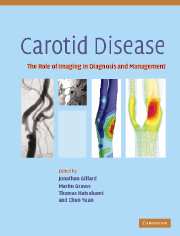Book contents
- Frontmatter
- Contents
- List of contributors
- List of abbreviations
- Introduction
- Background
- Luminal imaging techniques
- 9 Conventional carotid Doppler ultrasound
- 10 Conventional digital subtraction angiography for carotid disease
- 11 Magnetic resonance angiography of the carotid artery
- 12 Computed tomographic angiography of carotid artery stenosis
- 13 Cost-effectiveness analysis for carotid imaging
- Morphological plaque imaging
- Functional plaque imaging
- Plaque modelling
- Monitoring the local and distal effects of carotid interventions
- Monitoring pharmaceutical interventions
- Future directions in carotid plaque imaging
- Index
- References
12 - Computed tomographic angiography of carotid artery stenosis
from Luminal imaging techniques
Published online by Cambridge University Press: 03 December 2009
- Frontmatter
- Contents
- List of contributors
- List of abbreviations
- Introduction
- Background
- Luminal imaging techniques
- 9 Conventional carotid Doppler ultrasound
- 10 Conventional digital subtraction angiography for carotid disease
- 11 Magnetic resonance angiography of the carotid artery
- 12 Computed tomographic angiography of carotid artery stenosis
- 13 Cost-effectiveness analysis for carotid imaging
- Morphological plaque imaging
- Functional plaque imaging
- Plaque modelling
- Monitoring the local and distal effects of carotid interventions
- Monitoring pharmaceutical interventions
- Future directions in carotid plaque imaging
- Index
- References
Summary
Introduction
In large randomized trials carotid endarterectomy was shown to be beneficial in symptomatic patients (transient ischemic attack [TIA] or minor stroke in the past 6 months) with a severe stenosis (70–99%) of the internal carotid artery (ICA) (Rothwell et al., 2003). Subgroups of patients with a symptomatic stenosis of 50–69% also benefit from carotid endarterectomy. Recently, even for asymptomatic patients, a small effect of carotid endarterectomy was reported (Halliday et al., 2004). The discussion whether this effect was sufficiently large to advise surgery to (subgroups of) asymptomatic patients is still ongoing (Barnett, 2004). A more recent development is treatment of the carotid artery stenosis with endovascular stenting (Cambria, 2004). Randomized trials are still ongoing to assess the efficacy of this treatment. In the trials with symptomatic patients, an increasing degree of stenosis yielded increasing benefit from surgery. Therefore, precise estimation of the degree of stenosis is crucial for decisions on interventions for carotid artery atherosclerotic disease.
In the trials the degree of stenosis was assessed with intraarterial digital subtraction angiography (DSA), which consequently has become the standard of reference in the selection of patients for carotid endarterectomy. However, DSA has a nonnegligible morbidity and mortality, which decreases the potential overall benefit of endarterectomy (Hankey et al., 1990; Willinsky et al., 2003).
Keywords
- Type
- Chapter
- Information
- Carotid DiseaseThe Role of Imaging in Diagnosis and Management, pp. 158 - 165Publisher: Cambridge University PressPrint publication year: 2006
References
- 2
- Cited by



